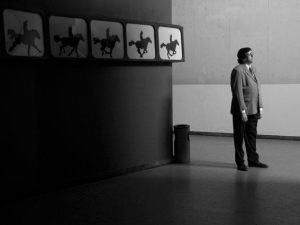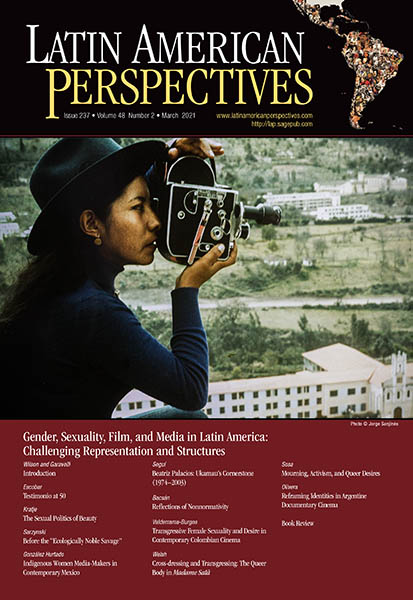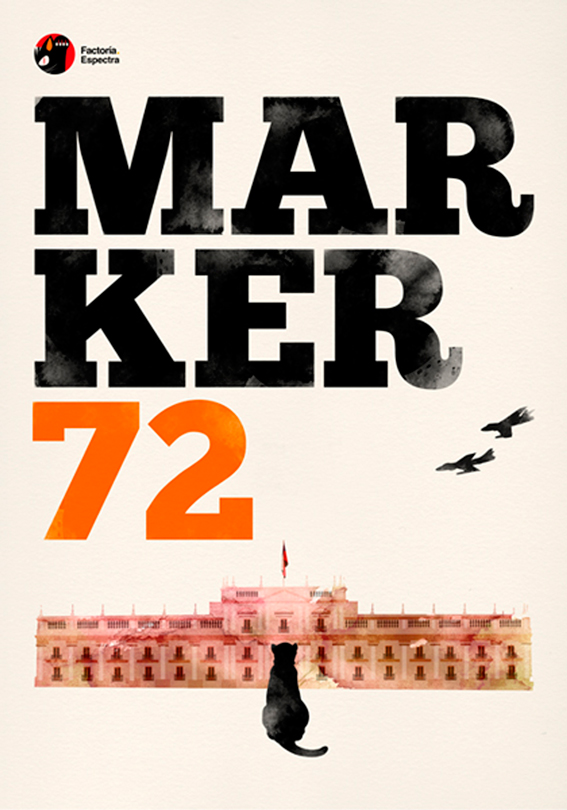 By: Oscar Moralde
By: Oscar Moralde
By: Kristi M. Wilson
In their imaginations they saw the cinema as a total and complete representation of reality; they saw in a trice the reconstruction of a perfect illusion of the outside world in sound, color, and relief.
—Andre Bazin
It is in the nature of analogical worlds to provoke a yearning for the past. . . . The digital will wants to change the world.
—D. N. Rodowick
La vida útil is simultaneously a cinephile’s dream picture, in its stylized look back at the history of cinema, and a biting satire about the fact that in the digital age of reproduction even the art of filmmaking has lost its aura. Uruguayan film buffs will recognize the film enthusiast and regular film festival patron Jorge Jellinek as the film’s central protagonist, Jorge, and the legendary film critic and real-life Cinemateca director Manuel Martínez Carril as a version of himself. Veiroj’s film captures the dying urban experience of going to the neighborhood movie theater—a collective encounter with celluloid and film history that, all over the world, is slowly but surely being replaced by private, digital, on-demand, and Hollywood multiplex practices of viewing. In this dark comedy about one man’s attempt to save Montevideo’s Cinemateca, an independent theater he has managed for 25 years, we get a glimpse of the many traditions that have helped shape the New Latin American cinema, a distinct film movement of which La vida útil can be considered a recent shining example.1
Under Marx’s paradigm for alienated labor, the artisanal connection between a worker and his or her product is broken under capitalist modes of production. Where art is concerned, Walter Benjamin (1969 [1955]) suggested that the age of mechanical reproduction brought the world works of art stripped of their context, their tradition, their authenticity, their “aura.” In film he saw a revolutionary potential to liquidate the “traditional value of cultural heritage” (221): One might subsume the eliminated element in the term “aura” and go on to say: that which withers in the age of mechanical reproduction is the aura of the work of art. This is a symptomatic process whose significance points beyond the realm of art. One might generalize by saying: the technique of reproduction detaches the reproduced object from the domain of tradition. By making many reproductions it substitutes a plurality of copies for a unique existence. And in permitting the reproduction to meet the Kristi Wilson is an assistant professor of rhetoric and composition and affiliate assistant professor of humanities at Soka University of America.
Beholder or listener in his own particular situation, it reactivates the object reproduced. These two processes lead to a shattering of tradition, which is the obverse of the contemporary crisis and renewal of mankind. Both processes are intimately connected with the contemporary mass movements. Their most powerful agent is the film.
La vida útil is a Latin American neorealist lament over the fact that going to the movies and national traditions of cinema are undergoing liquidation as their independent exhibition halls are becoming mega-churches, bingo houses, and spaces for global retail chains. This film celebrates the materiality of film and the physical space of its public exhibition over the digital technology that currently renders it obsolete. It also celebrates the Latin American movie theater as a national cultural marker that embodies a love for the art and history of cinema and the national hopes and aspirations of budding filmmakers like Veiroj, for whom its exhibition halls were a home away from home when he was younger. In a sequence in which a young Uruguayan filmmaker screens his new film to a nearly empty theater, Veiroj explicitly refers to the role of the cine in the early education of young Latin American filmmakers and its importance as a venue for the screening of their films.
In spite of the sad undercurrent of the film’s overall message, Veiroj (quoted in Trerotola, 2011: 15) initially imagined La vida útil as a love story of sorts: The original idea was to have the film relate more to the character of Jorge than with cinephilia. However, the workplace being a movie theater, topics relating to cinema had to be addressed; therefore, cinephilia would have to be an important context. But our intention was to construct a love story. Without paying homage to specific films, it was important to reference “film” as a whole, by exaggerating certain tools embraced by classical cinema, for example, and above all with the sensation of fantasy inherent in movies. In fact, a deep love for the dying art of cinema is exactly what makes this film humorous. A giant replica of a negative from Eadweard Muybridge’s The Horse in Motion series—one of earliest experiments with motion pictures—decorates the Cinemateca
lobby (Figure 1). There are several scenes that feature the deafening sounds of spinning film reels. The Cinemateca’s dwindling spectatorship is continually referenced by empty shots of the lobby. Only a handful of movie fans show up for the centennial of the Portuguese director Manoel de Oliveira. The subculture of intellectual film buffs, Figure 1. Jorge in the Cinemateca lobby (Photo Cinekdoque).
In the film, the Cinemateca, “one of Montevideo’s premier movie theaters for over 50 years,” is clearly underperforming and in danger of being liquidated by its parent foundation. Jorge is forced to sell two-for-one vouchers to keep the theater afloat, making a desperate plea to patrons reminding them that the “Cinemateca needs you” on the theater’s cassette-tape answering machine. Voucher schemes, cassette-tapes, pay phones, thick paper phone directories, film projectors, microphones, an entire archive
of canned films—none of the old forms of communication and cultural exchange can rescue the Cinemateca from its ultimate doom. Despite Jorge’s devotion to the cinema, the downward spiral of this cultural institution is as inevitable as Antonio’s return to unemployment once he loses his bicycle in Vittorio De Sica’s Bicycle Thief (1948). However, the film’s tragedy unfolds ironically, both laughing (painfully) at the endearing qualities of a collective of employees who have devoted their lives to a dying art form and paying homage to the great films of the past. Jorge, for example, is shown tallying the monthly debt totals for the theater on a notepad under a movie poster for Akira Kurosawa’s 1985 masterpiece Ran. On his way to the film reel storage room, he walks past a wall of forgotten DVD cases, one of which is now used to hide his keys and whose titles seem to scream for his attention. He barely endures Martínez’s radio lecture on the ways in which the films of Sergei Eisenstein and Orson Welles have helped to cultivate erudite spectators. A complex and often funny use of soundtrack references to great Westerns, melodramas, horror films, and psychedelic films of the 1960s and 1970s saves much of this potentially sad tale from taking on catastrophic dimensions. However, Veiroj (quoted in Trerotola, 2011: 15) points out that the situation in Uruguay and other Latin American countries is much worse in real life. When the funding finally does get pulled and eviction is imminent, Jorge walks away from the Cinemateca and into the bustling city. Having been told by a foundation representative that film was no longer a profitable cultural institution, Jorge’s life seems to lose its purpose. Like the homeless pensioner, Umberto, in another of De Sica’s neorealist classics, Umberto D (1952), he wanders the streets and contemplates suicide.2 The perfect illusion of the outside world once found in film has lost its magic. Ironically, however, the magic in Jorge’s life begins once he leaves the Cinemateca. Reminiscent of Luchino Visconti’s protagonist in Death in Venice (1971), Jorge wanders into a beauty salon, where he gets a haircut and shave in anticipation of a new romantic adventure. He is eventually saved when he tracks down a law professor he has had a crush on for a long time and works up the nerve to ask her out on a date. The swelling romantic soundtrack indicates that his life hangs in the balance. When she says yes, Jorge smiles for the first time and suggests that they “go to the movies.”
Sadly, however, as the film suggests, there will be fewer and fewer cultural institutions that support their shared passion. The defunding of the Cinemateca points to a common problem experienced by independent theaters all over the world: their inability to compete financially with Hollywood multiplex cinemas and, more important, with digital online viewing platforms (also dominated by North American entertainment industry monopolies). The consequences of this lack of funding go beyond the spaces of the movie theaters that are rapidly vanishing from urban landscapes like Montevideo. They have a direct impact on film preservation and distribution. Nationally funded independent theaters are the only venues for national cinema. They are also the keepers of film history (as suggested in La vida útil by the scene in which Jorge squeezes through rows and rows of canned films in the theater’s extensive archive). Thus, La vida útil is a bittersweet commentary on the life and death not only of the collective experience
of going to the movies but of the diverse national traditions of film production in Latin America. What remains at the end of the day is the movie fans, and now they must turn to the Hollywood multiplex or the Internet for solace.
Notes
1. In his anthology New Latin American Cinema, Michael T. Martin (1997b) discusses the long relationship between Latin American cities such as Rio, Montevideo, Buenos Aires, and Mexico City and European and, later, Hollywood cinema. Latin American filmmakers were largely overlooked until the 1960s, when films that responded to the deepening underdevelopment and economic and cultural dependency began to appear (especially in Argentina, Brazil, and Cuba). While New Latin American cinema can be understood as a continental approach to filmmaking that opposes capitalist exploitation and foreign domination as it affirms national and popular forms of cultural expression, Martin reminds us that it should not be understood as monolithic. For an expanded discussion of New Latin American cinema, see Martin (1997a; 1997b) and King, López, and Alvarado (1993). 2. Another example of New Latin American cinema, set in Medellín, Colombia, and deeply indebted to De Sica’s Umberto D, is Víctor Gavíria’s 1990 film Rodrigo D: No Future. It also features a scene in which the lead character wanders the streets of the city and contemplates suicide, only in this case he actually kills himself (see Wilson, 2007)
References
- Benjamin, W.
1969 (1955) “The work of art in the age of mechanical reproduction,” pp. 217–251 in H. Arendt (ed.), Illuminations. Translated by H. Zohn. New York: Schocken Books. - De Sica, V.
1948 Bicycles Thieves [Ladri di biciclette]. Produzione Films Vittorio De Sica.
1952 Umberto D. Rizzoli Film/Produzione Films Vittorio De Sica/Amato Film. - Gavíria, V.
1990 Rodrigo D: No Future. Compañia de Fomento Cinematográfico. FOCINE, Fotoclub-76. - King, J., A. M. López, and M. Alvarado (eds.).
1993. Mediating Two Worlds: Cinematic Encounters in the Americas. London: BFI Publishing. - Kurosawa, A.
1985 Ran. Greenwich Film Productions, Herald Ace, Nippon Herald Films. - Martin, M. T. (ed.).
1997a New Latin American Cinema. Vol. 1. Contemporary Film and Television. Detroit, MI: - WayneState University Press.
1997b New Latin American Cinema. Vol. 2. Studies of National Cinemas. Detroit, MI: Wayne State University Press. - Trerotola, D.
2011 “Ratón de cinemateca.” El Amante Cine, no. 230, 14–15. - Visconti, L.
1971 Death in Venice. Warner Brothers Pictures. - Wilson, Kristi
2007 “From pensioner to teenager: everyday violence in De Sica’s Umberto D and Gavíria’s
Rodrigo D: No Future,” pp. 144–164 in L. E. Ruberto and K. M. Wilson (eds.), Italian Neorealism and Global Cinema. Detroit, MI: Wayne State University Press.





